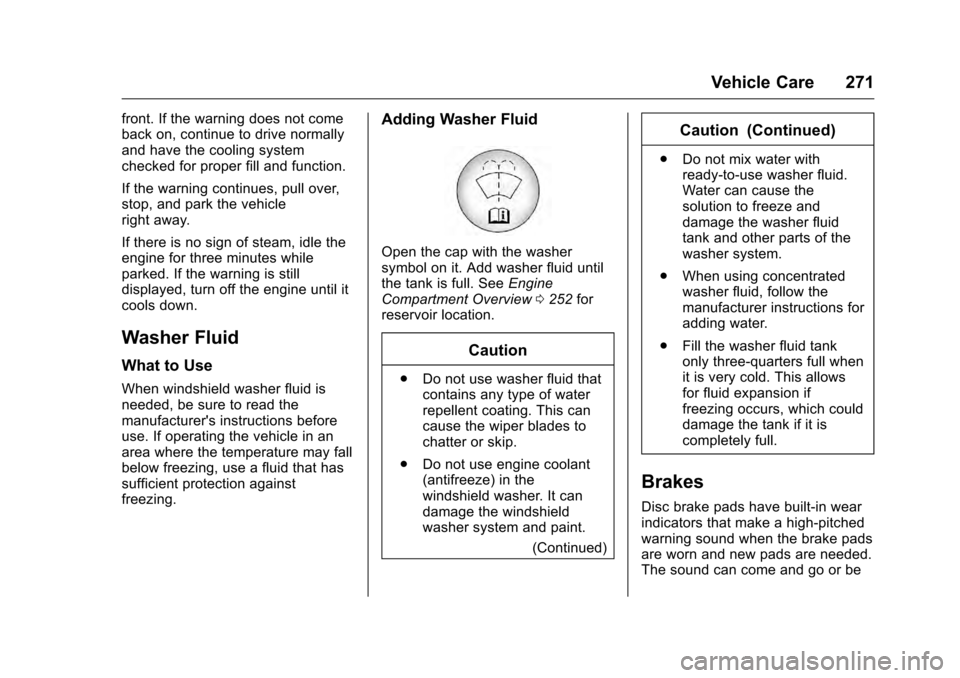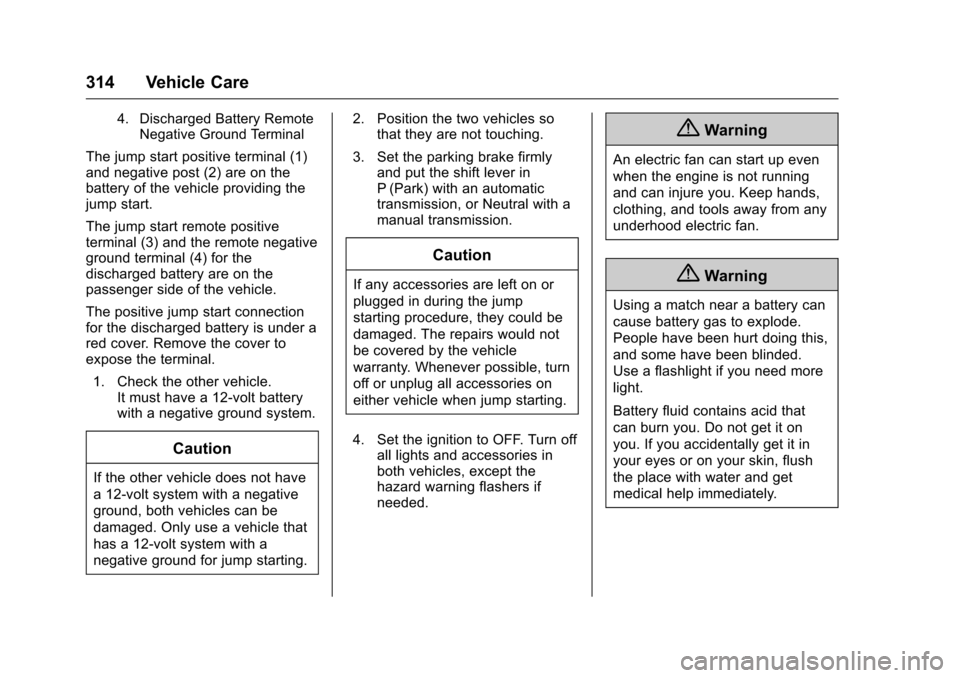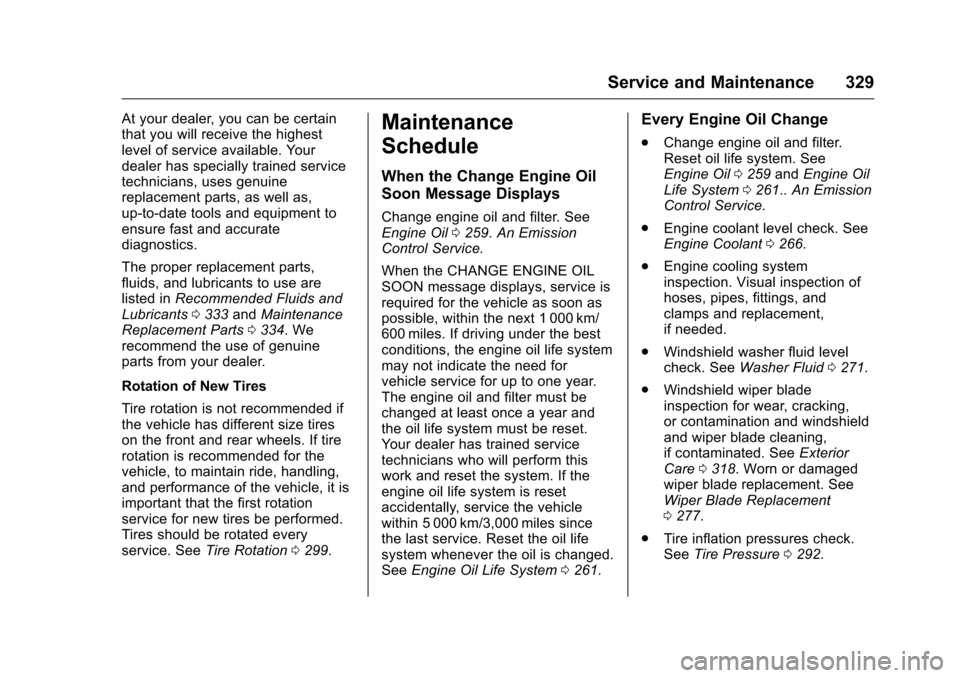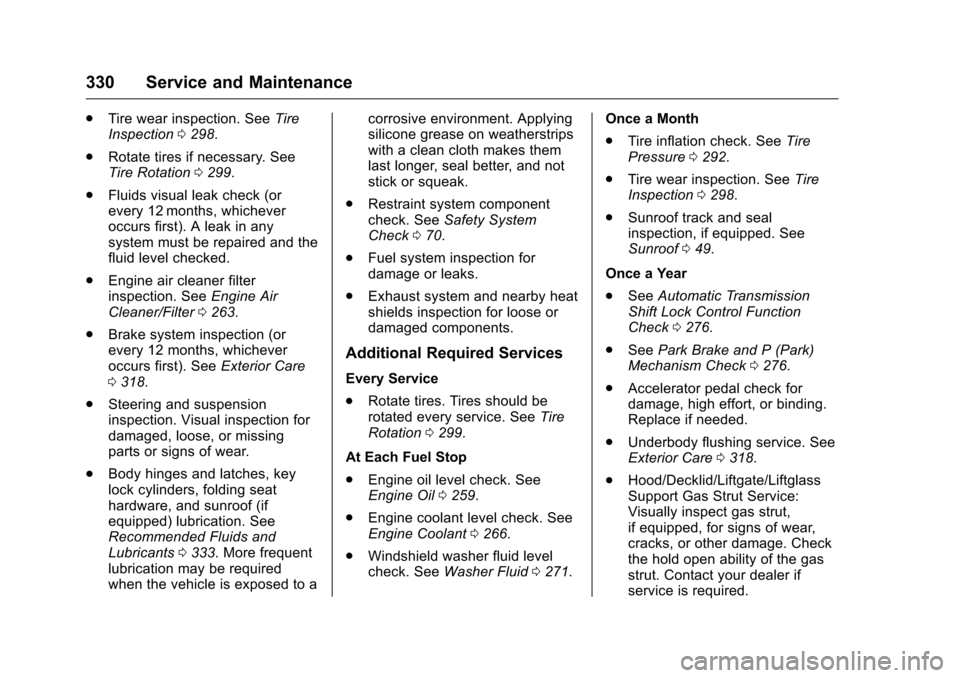check engine CADILLAC CTS 2016 3.G Owner's Guide
[x] Cancel search | Manufacturer: CADILLAC, Model Year: 2016, Model line: CTS, Model: CADILLAC CTS 2016 3.GPages: 354, PDF Size: 3.56 MB
Page 271 of 354

Cadillac CTS/CTS-V Owner Manual (GMNA-Localizing-MidEast-9369309) -
2016 - crc - 7/30/15
270 Vehicle Care
Then check to see if the engine
cooling fan is running. If the engine
is overheating, the fan should be
running. If it is not, do not continue
to run the engine. Have the vehicle
serviced.
Caution
Running the engine without
coolant may cause damage or a
fire. Vehicle damage would not be
covered by the vehicle warranty.
If Steam Is Coming from the
Engine Compartment
{Warning
Steam from an overheated engine
can burn you badly, even if you
just open the hood. Stay away
from the engine if you see or hear
steam coming from it. Just turn it
off and get everyone away from
the vehicle until it cools down.(Continued)
Warning (Continued)
Wait until there is no sign of
steam or coolant before you open
the hood.
If you keep driving when the
engine is overheated, the liquids
in it can catch fire. You or others
could be badly burned. Stop the
engine if it overheats, and get out
of the vehicle until the engine
is cool.
If Steam Is Coming from the
Engine Compartment with No
Overheat Warning
(V-Series Only)
The V-Series hood vent is
functional, and will allow water from
rain and car washes to enter the
engine compartment and contact
hot surfaces. If steam is seen
coming from the hood vent with no
accompanying overheat warning, no
action is required.
If No Steam Is Coming from
the Engine Compartment
If an engine overheat warning is
displayed but no steam can be seen
or heard, the problem may not be
too serious. Sometimes the engine
can get a little too hot when the
vehicle:
.Climbs a long hill on a hot day.
. Stops after high-speed driving.
. Idles for long periods in traffic.
If the overheat warning is displayed
with no sign of steam: 1. Turn the air conditioning off.
2. Turn the heater on to the highest temperature and to the
highest fan speed. Open the
windows as necessary.
3. When it is safe to do so, pull off the road, shift to P (Park) or
N (Neutral) and let the
engine idle.
If the overheat warning no longer
displays, the vehicle can be driven.
Continue to drive the vehicle slowly
for about 10 minutes. Keep a safe
vehicle distance from the vehicle in
Page 272 of 354

Cadillac CTS/CTS-V Owner Manual (GMNA-Localizing-MidEast-9369309) -
2016 - crc - 7/30/15
Vehicle Care 271
front. If the warning does not come
back on, continue to drive normally
and have the cooling system
checked for proper fill and function.
If the warning continues, pull over,
stop, and park the vehicle
right away.
If there is no sign of steam, idle the
engine for three minutes while
parked. If the warning is still
displayed, turn off the engine until it
cools down.
Washer Fluid
What to Use
When windshield washer fluid is
needed, be sure to read the
manufacturer's instructions before
use. If operating the vehicle in an
area where the temperature may fall
below freezing, use a fluid that has
sufficient protection against
freezing.
Adding Washer Fluid
Open the cap with the washer
symbol on it. Add washer fluid until
the tank is full. SeeEngine
Compartment Overview 0252 for
reservoir location.
Caution
. Do not use washer fluid that
contains any type of water
repellent coating. This can
cause the wiper blades to
chatter or skip.
. Do not use engine coolant
(antifreeze) in the
windshield washer. It can
damage the windshield
washer system and paint.
(Continued)
Caution (Continued)
.Do not mix water with
ready-to-use washer fluid.
Water can cause the
solution to freeze and
damage the washer fluid
tank and other parts of the
washer system.
. When using concentrated
washer fluid, follow the
manufacturer instructions for
adding water.
. Fill the washer fluid tank
only three-quarters full when
it is very cold. This allows
for fluid expansion if
freezing occurs, which could
damage the tank if it is
completely full.
Brakes
Disc brake pads have built-in wear
indicators that make a high-pitched
warning sound when the brake pads
are worn and new pads are needed.
The sound can come and go or be
Page 277 of 354

Cadillac CTS/CTS-V Owner Manual (GMNA-Localizing-MidEast-9369309) -
2016 - crc - 7/30/15
276 Vehicle Care
2. Firmly apply both the parkingbrake and the regular brake.
Do not use the accelerator
pedal, and be ready to turn off
the engine immediately if it
starts.
3. Try to start the engine in each gear. The vehicle should start
only in P (Park) or N (Neutral).
If the vehicle starts in any other
position, contact your dealer for
service.
Automatic Transmission
Shift Lock Control
Function Check
{Warning
When you are doing this
inspection, the vehicle could
move suddenly. If the vehicle
moves, you or others could be
injured. 1. Before starting this check, be
sure there is enough room
around the vehicle. It should be
parked on a level surface.
2. Firmly apply the parking brake. See Electric Parking Brake
0 204.
Be ready to apply the regular
brake immediately if the vehicle
begins to move.
3. With the engine off, turn the ignition on, but do not start the
engine. Without applying the
regular brake, try to move the
shift lever out of P (Park) with
normal effort. If the shift lever
moves out of P (Park), contact
your dealer for service.Park Brake and P (Park)
Mechanism Check
{Warning
When you are doing this check,
the vehicle could begin to move.
You or others could be injured
(Continued)
Warning (Continued)
and property could be damaged.
Make sure there is room in front
of the vehicle in case it begins to
roll. Be ready to apply the regular
brake at once should the vehicle
begin to move.
Park on a fairly steep hill, with the
vehicle facing downhill. Keeping
your foot on the regular brake, set
the parking brake.
. To check the parking brake's
holding ability: With the engine
running and the transmission in
N (Neutral), slowly remove foot
pressure from the regular brake
pedal. Do this until the vehicle is
held by the parking brake only.
. To check the P (Park)
mechanism's holding ability:
With the engine running, shift to
P (Park). Then release the
parking brake followed by the
regular brake.
Contact your dealer if service is
required.
Page 282 of 354

Cadillac CTS/CTS-V Owner Manual (GMNA-Localizing-MidEast-9369309) -
2016 - crc - 7/30/15
Vehicle Care 281
To identify and check fuses, circuit
breakers, and relays, seeEngine
Compartment Fuse Block 0281,
Instrument Panel Fuse Block 0284,
and Rear Compartment Fuse Block
0 287.
Engine Compartment
Fuse Block
The underhood fuse block is on the
passenger side of the engine
compartment.
Lift the fuse block cover to access
the fuses. The vehicle may not be equipped
with all of the fuses and relays
shown.
Caution
Spilling liquid on any electrical
component on the vehicle may
damage it. Always keep the
covers on any electrical
component.
Page 290 of 354

Cadillac CTS/CTS-V Owner Manual (GMNA-Localizing-MidEast-9369309) -
2016 - crc - 7/30/15
Vehicle Care 289
Number Usage44 Not used
45 Battery regulated voltage control
46 Engine control module battery
47 Not used
48 Not used
*49 Trailer module 50 Door lock security
51 Rear closure release
52 Not used
53 Not used
54 Door lock security
55 Not used
*56 Fuel door
* OptionalWheels and Tires
Tires
Every new GM vehicle has
high-quality tires made by a
leading tire manufacturer. See
the warranty manual for
information regarding the tire
warranty and where to get
service. For additional
information refer to the tire
manufacturer.
{Warning
.Poorly maintained and
improperly used tires are
dangerous.
.Overloading the tires can
cause overheating as a
result of too much
flexing. There could be a
blowout and a serious
crash. See Vehicle Load
Limits 0189.
(Continued)
Warning (Continued)
.Underinflated tires pose
the same danger as
overloaded tires. The
resulting crash could
cause serious injury.
Check all tires frequently
to maintain the
recommended pressure.
Tire pressure should be
checked when the tires
are cold.
.Overinflated tires are
more likely to be cut,
punctured, or broken by
a sudden impact —such
as when hitting a pothole.
Keep tires at the
recommended pressure.
.Worn or old tires can
cause a crash. If the
tread is badly worn,
replace them.
(Continued)
Page 315 of 354

Cadillac CTS/CTS-V Owner Manual (GMNA-Localizing-MidEast-9369309) -
2016 - crc - 7/30/15
314 Vehicle Care
4. Discharged Battery RemoteNegative Ground Terminal
The jump start positive terminal (1)
and negative post (2) are on the
battery of the vehicle providing the
jump start.
The jump start remote positive
terminal (3) and the remote negative
ground terminal (4) for the
discharged battery are on the
passenger side of the vehicle.
The positive jump start connection
for the discharged battery is under a
red cover. Remove the cover to
expose the terminal.
1. Check the other vehicle. It must have a 12-volt battery
with a negative ground system.
Caution
If the other vehicle does not have
a 12-volt system with a negative
ground, both vehicles can be
damaged. Only use a vehicle that
has a 12-volt system with a
negative ground for jump starting. 2. Position the two vehicles so
that they are not touching.
3. Set the parking brake firmly and put the shift lever in
P (Park) with an automatic
transmission, or Neutral with a
manual transmission.
Caution
If any accessories are left on or
plugged in during the jump
starting procedure, they could be
damaged. The repairs would not
be covered by the vehicle
warranty. Whenever possible, turn
off or unplug all accessories on
either vehicle when jump starting.
4. Set the ignition to OFF. Turn off all lights and accessories in
both vehicles, except the
hazard warning flashers if
needed.
{Warning
An electric fan can start up even
when the engine is not running
and can injure you. Keep hands,
clothing, and tools away from any
underhood electric fan.
{Warning
Using a match near a battery can
cause battery gas to explode.
People have been hurt doing this,
and some have been blinded.
Use a flashlight if you need more
light.
Battery fluid contains acid that
can burn you. Do not get it on
you. If you accidentally get it in
your eyes or on your skin, flush
the place with water and get
medical help immediately.
Page 330 of 354

Cadillac CTS/CTS-V Owner Manual (GMNA-Localizing-MidEast-9369309) -
2016 - crc - 7/30/15
Service and Maintenance 329
At your dealer, you can be certain
that you will receive the highest
level of service available. Your
dealer has specially trained service
technicians, uses genuine
replacement parts, as well as,
up-to-date tools and equipment to
ensure fast and accurate
diagnostics.
The proper replacement parts,
fluids, and lubricants to use are
listed inRecommended Fluids and
Lubricants 0333 andMaintenance
Replacement Parts 0334. We
recommend the use of genuine
parts from your dealer.
Rotation of New Tires
Tire rotation is not recommended if
the vehicle has different size tires
on the front and rear wheels. If tire
rotation is recommended for the
vehicle, to maintain ride, handling,
and performance of the vehicle, it is
important that the first rotation
service for new tires be performed.
Tires should be rotated every
service. See Tire Rotation 0299.Maintenance
Schedule
When the Change Engine Oil
Soon Message Displays
Change engine oil and filter. See
Engine Oil 0259. An Emission
Control Service.
When the CHANGE ENGINE OIL
SOON message displays, service is
required for the vehicle as soon as
possible, within the next 1 000 km/
600 miles. If driving under the best
conditions, the engine oil life system
may not indicate the need for
vehicle service for up to one year.
The engine oil and filter must be
changed at least once a year and
the oil life system must be reset.
Your dealer has trained service
technicians who will perform this
work and reset the system. If the
engine oil life system is reset
accidentally, service the vehicle
within 5 000 km/3,000 miles since
the last service. Reset the oil life
system whenever the oil is changed.
See Engine Oil Life System 0261.
Every Engine Oil Change
.
Change engine oil and filter.
Reset oil life system. See
Engine Oil 0259 and Engine Oil
Life System 0261.. An Emission
Control Service.
. Engine coolant level check. See
Engine Coolant 0266.
. Engine cooling system
inspection. Visual inspection of
hoses, pipes, fittings, and
clamps and replacement,
if needed.
. Windshield washer fluid level
check. See Washer Fluid 0271.
. Windshield wiper blade
inspection for wear, cracking,
or contamination and windshield
and wiper blade cleaning,
if contaminated. See Exterior
Care 0318. Worn or damaged
wiper blade replacement. See
Wiper Blade Replacement
0 277.
. Tire inflation pressures check.
See Tire Pressure 0292.
Page 331 of 354

Cadillac CTS/CTS-V Owner Manual (GMNA-Localizing-MidEast-9369309) -
2016 - crc - 7/30/15
330 Service and Maintenance
.Tire wear inspection. See Tire
Inspection 0298.
. Rotate tires if necessary. See
Tire Rotation 0299.
. Fluids visual leak check (or
every 12 months, whichever
occurs first). A leak in any
system must be repaired and the
fluid level checked.
. Engine air cleaner filter
inspection. See Engine Air
Cleaner/Filter 0263.
. Brake system inspection (or
every 12 months, whichever
occurs first). See Exterior Care
0 318.
. Steering and suspension
inspection. Visual inspection for
damaged, loose, or missing
parts or signs of wear.
. Body hinges and latches, key
lock cylinders, folding seat
hardware, and sunroof (if
equipped) lubrication. See
Recommended Fluids and
Lubricants 0333. More frequent
lubrication may be required
when the vehicle is exposed to a corrosive environment. Applying
silicone grease on weatherstrips
with a clean cloth makes them
last longer, seal better, and not
stick or squeak.
. Restraint system component
check. See Safety System
Check 070.
. Fuel system inspection for
damage or leaks.
. Exhaust system and nearby heat
shields inspection for loose or
damaged components.
Additional Required Services
Every Service
.Rotate tires. Tires should be
rotated every service. See Tire
Rotation 0299.
At Each Fuel Stop
. Engine oil level check. See
Engine Oil 0259.
. Engine coolant level check. See
Engine Coolant 0266.
. Windshield washer fluid level
check. See Washer Fluid 0271. Once a Month
.
Tire inflation check. See Tire
Pressure 0292.
. Tire wear inspection. See Tire
Inspection 0298.
. Sunroof track and seal
inspection, if equipped. See
Sunroof 049.
Once a Year
. See Automatic Transmission
Shift Lock Control Function
Check 0276.
. See Park Brake and P (Park)
Mechanism Check 0276.
. Accelerator pedal check for
damage, high effort, or binding.
Replace if needed.
. Underbody flushing service. See
Exterior Care 0318.
. Hood/Decklid/Liftgate/Liftglass
Support Gas Strut Service:
Visually inspect gas strut,
if equipped, for signs of wear,
cracks, or other damage. Check
the hold open ability of the gas
strut. Contact your dealer if
service is required.
Page 332 of 354

Cadillac CTS/CTS-V Owner Manual (GMNA-Localizing-MidEast-9369309) -
2016 - crc - 7/30/15
Service and Maintenance 331
.Engine air cleaner filter
replacement or every 20 000 km/
12,500 Miles. If driving in dusty
conditions, inspect the filter at
each oil change or more often as
needed. See Engine Air Cleaner/
Filter 0263.
Every 40 000 km/25,000 Miles
. Passenger compartment air filter
replacement (or every
24 months, whichever occurs
first). More frequent replacement
may be needed if the vehicle is
driven in areas with heavy traffic,
poor air quality, areas with high
dust levels or are sensitive to
environmental allergens. Cabin
Air Filter replacement may also
be needed if you notice reduced
airflow, windows fogging up,
or odors. Your local GM Service
location can help you determine
when it is the right time to
replace your filter.
Every 72 000 km/45,000 Miles
. Replace brake fluid (or every
three years, whichever occurs
first). .
Rear axle fluid (If equipped with
limited slip).
Every 80 000 km/50,000 Miles
. Evaporative control system
inspection. Check all fuel and
vapor lines and hoses for proper
hook-up, routing, and condition.
Every 96 000 km/60,000 Miles
. Replace spark plugs. Inspect
spark plug wires. (2.0L LTG and
3.6L LF3 Turbo Engines)
Every 156 000 km/97,500 Miles
. Replace spark plugs. Inspect
spark plug wires. (3.6L LGX and
6.2L LT4 Engines)
Every 240 000 km/150,000 Miles
. Engine cooling system drain and
refill (or every five years,
whichever occurs first). See
Cooling System 0264. An
Emission Control Service.
. Engine drive belts inspection for
fraying, excessive cracks,
or obvious damage (or every
10 years, whichever occurs
first). Replace, if needed.Severe Conditions Requiring
More Frequent Maintenance*
.Public service, military,
or commercial use vehicles to
include the following:
‐Ambulances, police cars and
emergency rescue vehicles.
‐ Civilian vehicles such as light
duty pick-up trucks, SUVs and
passenger cars that are used
in military applications.
‐ Recovery vehicles such as
tow trucks and flatbed single
vehicle carriers or any vehicle
that is consistently used in
towing trailers or other loads.
‐ High use commercial vehicles
such as courier delivery
vehicles, private security patrol
vehicles or any vehicles that
operate on a 24 hour basis.
‐ Any vehicle consistently
operated in a high sand or
dust environment such as
those used on oil pipelines
and similar applications.
Page 340 of 354

Cadillac CTS/CTS-V Owner Manual (GMNA-Localizing-MidEast-9369309) -
2016 - crc - 7/30/15
Technical Data 339
ApplicationCapacities
Metric English
Fuel Tank 72 L 19 gal
Transfer Case –AWD 0.8 L0.8 qt
Rear Axle (with limited slip) 1.2 L1.3 qt
Wheel Nut Torque 150Y 110 lb ft
All capacities are approximate. When adding, be sure to fill to the approximate level, as recommended in this
manual. Recheck fluid level after filling.
Engine Specifications
Engine VIN Code Horsepower TorqueSpark Plug Gap
2.0L L4
Engine (LTG) X 203 kW@ 5500 rpm
(272 hp@5500 rpm) 400
Y @3000 rpm
(295 lb ft @ 3000 rpm) 0.75–0.90 mm (0.030–
0.035 in)
3.6L
V6 Engine (LGX) S 250 kW@ 6900 rpm
(335 hp@6900 rpm) 372
Y @4800 rpm
(275 lb ft @ 4800 rpm) 0.80–0.90 mm (0.031–
0.035 in)
3.6L
V6 Engine (LF3) 8 477 kW@ 6400 rpm
(640 hp@ 6400 rpm) 864
Y @3600 rpm
(630 lb ft @ 3600 rpm) 0.75–0.90 mm (0.030–
0.035 in)
6.2L V8 Engine
(V-Series) 6 485 kW@ 6400 rpm
(650 hp@ 6400 rpm) 861
Y @3600 rpm
(650 lb ft @ 3600 rpm) 0.725–0.875 mm (0.029–
0.034 in)